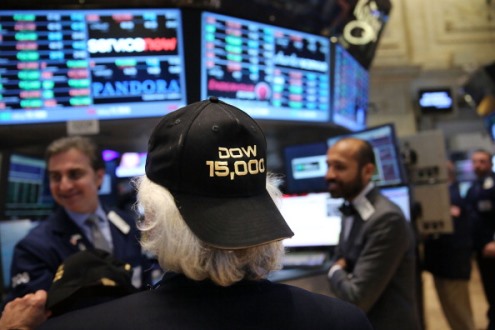Personal Wealth Management / Behavioral Finance
Assessing Acrophobia
As several popular indexes have surpassed their past peaks recently, market acrophobia—fear of heights—seems to have increased dramatically. But bull markets don’t share our earthbound proclivities.
Hats were passed out to NYSE traders to celebrate the Dow passing 15,000. The hats also served the dual purpose of protecting from the sky potentially falling. Source: Getty Images.
The Dow crossed 15,000 earlier this week and headlines (seemingly on cue) bemoaned the disconnect between market highs and what’s so far been seemingly just ok economic growth. Others, too, chimed in with arguments justifying fears of new market highs and bubbles. Of course, we’ve panned the price-weighted Dow as a poor proxy for broader markets myriad times, but what of the S&P? It surpassed its past highs recently too—and broke through 1600 days later. Scary! But should it be?
Acrophobia—the fear of heights—is fairly common and has been around for a while. Not since we swung from the trees have most of us been good with heights. Our survival instinct kicks in and tell us high places, like mountain (or stock market) summits are bad places for us to be if we want to see tomorrow. With mountains, the fear is easily justified—our ability to independently sustain flight is pretty limited. With markets, the fear is a little harder to assess—it’s rooted in the fact we hate losses more than we love gains—myopic loss aversion. But markets, specifically bull markets, don’t share our earthbound proclivities. More often than not, they push past previous highs and keep rising for months and more frequently years—well-eclipsing past records. Was the S&P “too high” when it regained its prior peak of 370 on March 1, 1991? Or when it surpassed 142 on November 3, 1982? Of course not. Hindsight gives us perspective, and those two bulls ran for about nine and five more years, respectively, setting dozens of new highs along the way. The index level—record high or no—isn’t predictive of anything. It’s just a number. But foresight requires us to question market acrophobia and fears squawked about in headlines with a little more scrutiny to determine where the market’s headed.
There’s one thing we certainly agree with in the comparison of stocks and the economy. It’s that the gap between the two does determine much of stocks’ movements. Yet, today, we’d argue that gap is nearly the exact opposite of most commentary—sentiment is skeptical of better-than-appreciated fundamentals.
For this bull’s duration, stock prices have moved almost in lockstep with after-tax corporate profits. Said differently, global stock market valuations, based on the 12-month forward P/E of the MSCI World, are below the average of the last 25 years. Multiples haven’t expanded much in this bull market as of yet. Bubbles typically happen when we see the opposite, prices disconnected from fundamentals driven by optimism. (Not unlike the tech bubble’s height when many investors were paying a premium for loss-making firms that lacked viable business models.) That’s just not the case today. What’s more, the rampant acrophobia that’s so easy to find is yet another factor suggesting this bull has room to run.
If you would like to contact the editors responsible for this article, please message MarketMinder directly.
*The content contained in this article represents only the opinions and viewpoints of the Fisher Investments editorial staff.
Get a weekly roundup of our market insights
Sign up for our weekly e-mail newsletter.

See Our Investment Guides
The world of investing can seem like a giant maze. Fisher Investments has developed several informational and educational guides tackling a variety of investing topics.






